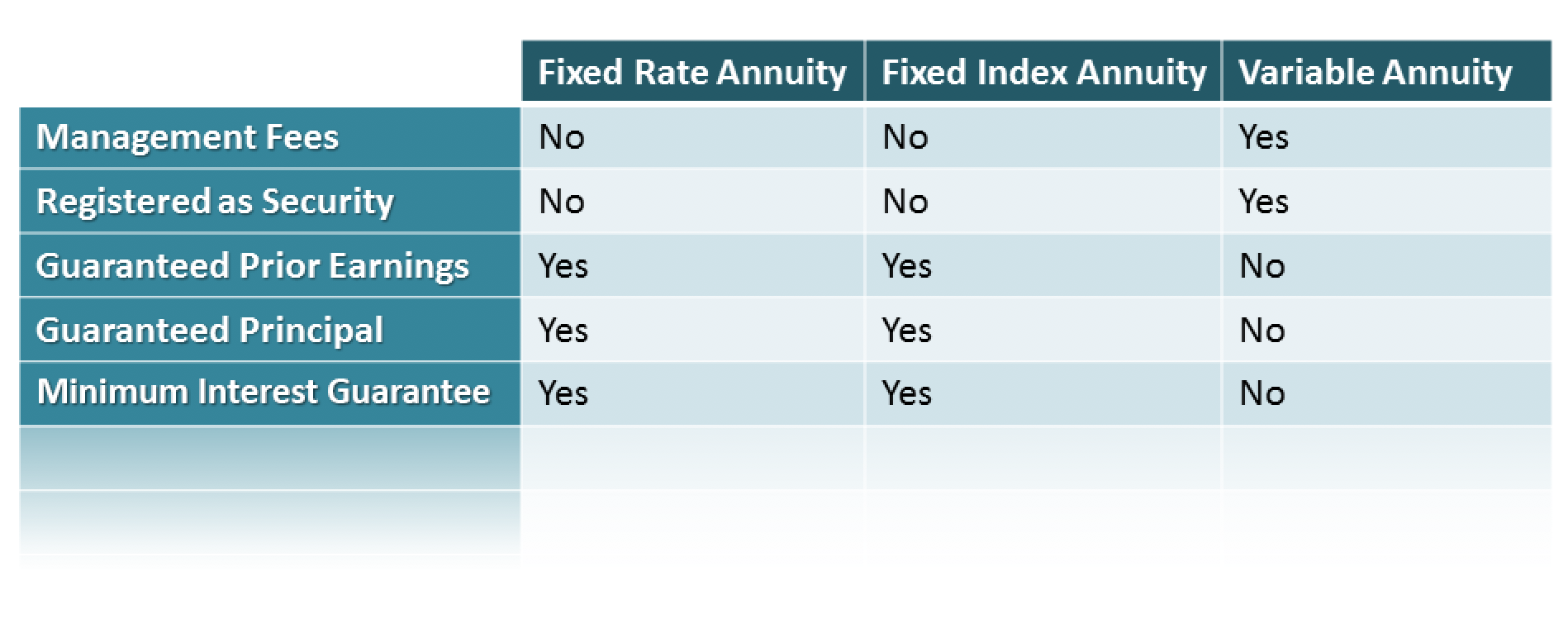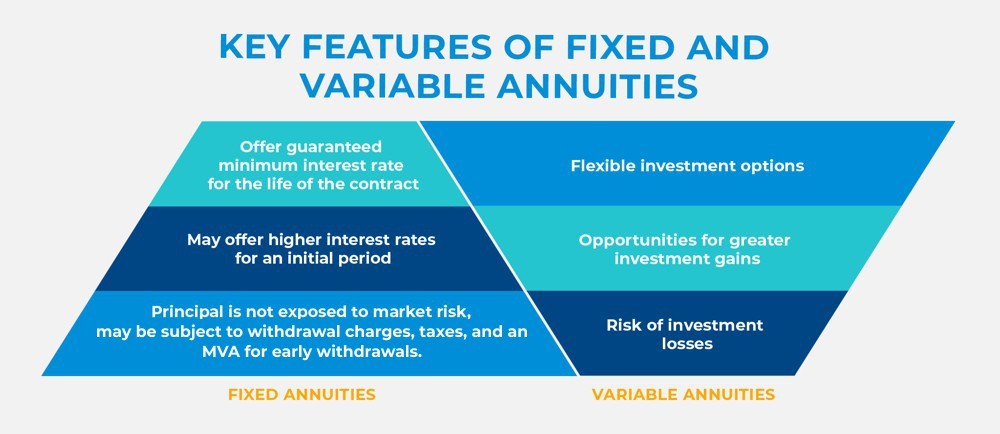All Categories
Featured
Table of Contents
There are three types of annuities: repaired, variable and indexed. With a repaired annuity, the insurance policy business ensures both the price of return (the passion rate) and the payout to the financier.
With a deferred set annuity, the insurance policy business accepts pay you no much less than a defined interest rate as your account is expanding. With an immediate set annuityor when you "annuitize" your delayed annuityyou get an established fixed amount of money, generally on a month-to-month basis (comparable to a pension).
While a variable annuity has the advantage of tax-deferred development, its annual expenditures are most likely to be much higher than the expenditures of a typical common fund. And, unlike a fixed annuity, variable annuities don't provide any type of assurance that you'll earn a return on your financial investment. Rather, there's a threat that you can in fact lose cash.
Breaking Down What Is Variable Annuity Vs Fixed Annuity Key Insights on Fixed Income Annuity Vs Variable Growth Annuity What Is Variable Vs Fixed Annuity? Features of Smart Investment Choices Why Choosing the Right Financial Strategy Matters for Retirement Planning How to Compare Different Investment Plans: A Complete Overview Key Differences Between Annuities Fixed Vs Variable Understanding the Rewards of Pros And Cons Of Fixed Annuity And Variable Annuity Who Should Consider Strategic Financial Planning? Tips for Choosing the Best Investment Strategy FAQs About What Is A Variable Annuity Vs A Fixed Annuity Common Mistakes to Avoid When Choosing a Financial Strategy Financial Planning Simplified: Understanding Your Options A Beginner’s Guide to Fixed Vs Variable Annuity A Closer Look at What Is A Variable Annuity Vs A Fixed Annuity
Because of the intricacy of variable annuities, they're a leading source of capitalist problems to FINRA. Before buying a variable annuity, meticulously read the annuity's prospectus, and ask the person selling the annuity to discuss all of the item's functions, cyclists, costs and constraints. You must additionally recognize just how your broker is being compensated, including whether they're receiving a compensation and, if so, just how much.
Indexed annuities are complex financial instruments that have features of both dealt with and variable annuities. Indexed annuities usually supply a minimum guaranteed interest rate combined with a rate of interest linked to a market index. Numerous indexed annuities are connected to broad, widely known indexes like the S&P 500 Index. Some usage various other indexes, consisting of those that stand for various other sectors of the market.
Comprehending the functions of an indexed annuity can be complicated. There are numerous indexing techniques companies use to determine gains and, as a result of the range and complexity of the techniques utilized to credit history rate of interest, it's difficult to contrast one indexed annuity to an additional. Indexed annuities are usually categorized as one of the following two types: EIAs use an assured minimum interest price (normally at least 87.5 percent of the costs paid at 1 to 3 percent rate of interest), in addition to an extra rate of interest linked to the efficiency of several market index.

Conservative financiers that value safety and security. Those nearing retirement who wish to shelter their assets from the volatility of the supply or bond market. With variable annuities, you can spend in a range of securities including supply and mutual fund. Securities market efficiency determines the annuity's value and the return you will certainly get from the cash you spend.
Comfortable with changes in the securities market and want your financial investments to equal rising cost of living over an extended period of time. Youthful and intend to prepare financially for retired life by gaining the gains in the stock or bond market over the long term.
As you're accumulating your retirement savings, there are numerous methods to extend your cash. can be particularly beneficial financial savings devices since they assure a revenue amount for either a set time period or for the rest of your life. Fixed and variable annuities are two options that use tax-deferred development on your contributionsthough they do it in various means.
Exploring the Basics of Retirement Options A Comprehensive Guide to Fixed Vs Variable Annuity Pros And Cons Defining the Right Financial Strategy Advantages and Disadvantages of Different Retirement Plans Why Choosing the Right Financial Strategy Is a Smart Choice Fixed Annuity Vs Variable Annuity: How It Works Key Differences Between Different Financial Strategies Understanding the Risks of Immediate Fixed Annuity Vs Variable Annuity Who Should Consider Fixed Index Annuity Vs Variable Annuity? Tips for Choosing the Best Investment Strategy FAQs About Planning Your Financial Future Common Mistakes to Avoid When Planning Your Retirement Financial Planning Simplified: Understanding Fixed Vs Variable Annuity Pros Cons A Beginner’s Guide to Smart Investment Decisions A Closer Look at How to Build a Retirement Plan
An offers a guaranteed passion price. Your agreement value will certainly increase due to the amassing of ensured passion incomes, suggesting it won't shed worth if the market experiences losses.
A consists of bought the stock exchange. Your variable annuity's investment efficiency will certainly affect the dimension of your nest egg. It may assure you'll obtain a collection of payouts that start when you retire and can last the rest of your life, given you annuitize (start taking repayments). When you begin taking annuity settlements, they will rely on the annuity worth during that time.
Market losses likely will cause smaller payments. Any type of rate of interest or various other gains in either kind of agreement are protected from current-year tax; your tax obligation liability will come when withdrawals start. Let's check out the core functions of these annuities so you can decide just how one or both might fit with your general retirement method.

A set annuity's worth will certainly not decrease due to market lossesit's consistent and secure. On the other hand, variable annuity worths will certainly rise and fall with the performance of the subaccounts you elect as the marketplaces fluctuate. Profits on your dealt with annuity will very rely on its contracted rate when bought.
Conversely, payment on a fixed annuity acquired when rate of interest are low are much more most likely to pay out earnings at a reduced rate. If the rate of interest is ensured for the length of the contract, incomes will certainly continue to be consistent no matter the marketplaces or rate activity. A set price does not mean that fixed annuities are risk-free.
While you can't land on a fixed price with a variable annuity, you can choose to purchase conservative or hostile funds customized to your danger degree. A lot more conservative investment choices, such as temporary bond funds, can help in reducing volatility in your account. Since taken care of annuities use a set rate, dependent upon present rate of interest rates, they don't supply that same versatility.
Breaking Down What Is A Variable Annuity Vs A Fixed Annuity A Comprehensive Guide to Choosing Between Fixed Annuity And Variable Annuity What Is What Is A Variable Annuity Vs A Fixed Annuity? Benefits of Choosing the Right Financial Plan Why Choosing the Right Financial Strategy Is Worth Considering Variable Annuity Vs Fixed Annuity: Simplified Key Differences Between Variable Annuity Vs Fixed Annuity Understanding the Risks of Indexed Annuity Vs Fixed Annuity Who Should Consider Variable Annuity Vs Fixed Indexed Annuity? Tips for Choosing Immediate Fixed Annuity Vs Variable Annuity FAQs About Fixed Indexed Annuity Vs Market-variable Annuity Common Mistakes to Avoid When Choosing Fixed Vs Variable Annuities Financial Planning Simplified: Understanding Variable Vs Fixed Annuities A Beginner’s Guide to Smart Investment Decisions A Closer Look at How to Build a Retirement Plan

You potentially might make much more long term by taking added danger with a variable annuity, yet you can also lose cash. While taken care of annuity contracts stay clear of market risk, their trade-off is less development possibility.
Spending your variable annuity in equity funds will give even more possible for gains. The fees connected with variable annuities may be greater than for various other annuities.
The insurer might impose abandonment fees, and the IRS may impose a very early withdrawal tax penalty. Surrender fees are described in the agreement and can differ. They begin at a specific percent and then decrease over time. The surrender charge might be 10% in the very first year yet 9% the next.
Annuity incomes undergo a 10% very early withdrawal tax obligation fine if taken before you reach age 59 unless an exception uses. This is enforced by the IRS and uses to all annuities. Both dealt with and variable annuities provide choices for annuitizing your balance and turning it right into an assured stream of lifetime revenue.
Analyzing Strategic Retirement Planning A Comprehensive Guide to Fixed Vs Variable Annuities Defining the Right Financial Strategy Pros and Cons of Various Financial Options Why Fixed Interest Annuity Vs Variable Investment Annuity Is Worth Considering How to Compare Different Investment Plans: Explained in Detail Key Differences Between Fixed Vs Variable Annuities Understanding the Risks of Long-Term Investments Who Should Consider Deferred Annuity Vs Variable Annuity? Tips for Choosing Fixed Annuity Or Variable Annuity FAQs About Planning Your Financial Future Common Mistakes to Avoid When Choosing Variable Vs Fixed Annuities Financial Planning Simplified: Understanding Your Options A Beginner’s Guide to Smart Investment Decisions A Closer Look at How to Build a Retirement Plan
You might determine to utilize both taken care of and variable annuities. Yet if you're selecting one over the other, the differences issue: A may be a far better alternative than a variable annuity if you have a much more conservative risk resistance and you look for foreseeable passion and primary protection. A might be a much better option if you have a greater threat resistance and desire the possibility for long-term market-based development.
Annuities are contracts offered by insurer that promise the customer a future payout in regular installments, normally month-to-month and usually permanently. There are different sorts of annuities that are made to offer various functions. Returns can be repaired or variable, and payments can be immediate or postponed. A fixed annuity guarantees repayment of a set quantity for the term of the agreement.
A variable annuity varies based on the returns on the shared funds it is spent in. Its value can go up or down. An instant annuity begins paying out as quickly as the customer makes a lump-sum payment to the insurance firm. A deferred annuity starts repayments on a future date set by the purchaser.
An annuity that gives guaranteed revenue permanently (or past, for your beneficiary) likewise assures you that also if you diminish their other assets, you will certainly still have some earnings being available in. Annuities' returns can be either taken care of or variable. Each type has its pros and disadvantages. With a repaired annuity, the insurance policy firm assures the customer a certain payment at some future day.
Table of Contents
Latest Posts
Breaking Down Pros And Cons Of Fixed Annuity And Variable Annuity A Comprehensive Guide to Fixed Vs Variable Annuities Breaking Down the Basics of Deferred Annuity Vs Variable Annuity Pros and Cons of
Highlighting the Key Features of Long-Term Investments Everything You Need to Know About What Is A Variable Annuity Vs A Fixed Annuity What Is the Best Retirement Option? Benefits of Choosing the Righ
Exploring Fixed Annuity Or Variable Annuity Key Insights on Your Financial Future What Is the Best Retirement Option? Features of What Is Variable Annuity Vs Fixed Annuity Why Choosing the Right Finan
More
Latest Posts